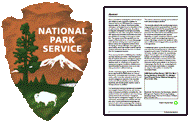United States National Park Service

United States National Park Service: Publications
Date of this Version
6-2013
Citation
Natural Resource Report NPS/SEKI/ NRR—2013/665.16 / NPS 102/121140, June 2013: iii, 28 pages
Published by the United States Department of the Interior, National Park Service, Natural Resource Stewardship and Science, Fort Collins, Colorado
Also available at: http://www.nature.nps.gov/publications/nrpm/
Please cite this publication as:
A. Chung-MacCoubrey. 2013. A natural resource condition assessment for Sequoia and Kings Canyon National Parks: Appendix 16 – bats. Natural Resource Report NPS/SEKI/NRR—2013/665.16. National Park Service, Fort Collins, Colorado.
Abstract
Scope of Analysis
North American bats are highly unique animals that have historically been overlooked by land managers and misunderstood by the public. Bats are unique as the only true flying mammals and due to their exceptionally long lives (5-15 years) and unusually low reproductive rates (typically one young per year) for their small size. Most North American bat species are insectivorous, serve as the primary predators of nocturnal insects, and can consume up to one-third of their weight in insects per night. Thus, bats play a role in regulating insect populations, insect-related ecological processes, and nutrient redistribution and cycling (Ross 1967) and are integral to the function and integrity of many ecosystems. Through this role, bats also provide tangible economic benefits. For example, Mexican free-tailed bats (Tadarida brasiliensis) consume significant quantities of several moth species whose larvae are known agricultural pests (e.g. corn earworm, Helicoverpa zea) and provide significant economic value in pest control services to the agriculture industry (Cleveland et al. 2009). Because of their small size, the energetic demands of flight, a limited ability to store fat, and the seasonal abundance of their prey, bats have an annual energy budget that is difficult to balance (McNab 1982). Many species rely on hibernation as a critical strategy to survive the winter. In the fall, these bats accumulate up to 30% of their body weight in fat to prepare for the winter hibernation. During hibernation, bats lower their body temperature to 1-2 degrees above ambient, reduce their heart rate and respiration, and thus minimize their basal metabolic energy requirements. Bats emerge in the spring with depleted energy stores, and adult females may be pregnant from fall matings. During spring and summer, female bats feed heavily to replenish their energy reserves, gestate fetuses that grow to 10-15% of the female’s weight, and provide rich milk for growing pups. In the fall, adults and young-of-the-year forage heavily in preparation for the winter.
Because of their tight energy budgets, bats require roosts with appropriate microclimates to minimize thermoregulatory energy requirements (Kunz 1982, Hill and Smith 1984). As such, reproductive success and overwinter survival of individuals and populations may largely depend on the availability of suitable roosts (Humphrey 1975). Not only do they minimize thermoregulatory requirements, suitable roosts also facilitate gestation in pregnant females and maximize growth rates of young pups. Many species often congregate into winter hibernacula or summer maternity colonies to reap thermoregulatory and other communal benefits. This colony roosting behavior also makes bats susceptible in large numbers to impacts such as disturbance, vandalism, cave and mine closures, destruction of roosts, disease, etc. The overall distribution and abundance of suitable roost sites (summer and winter) may ultimately determine the distribution and abundance of many bat species (Humphrey 1975).
Based on physiological adaptations to water conservation of lack thereof, bats must find roosts and foraging areas that have water within an economical flight distance. Nonetheless, roost and foraging habitat may still be separated by significant distances (Pierson 1998, Chambers et al. 2006). Food availability also determines bat species distribution and habitat use. Although insects appear to be so abundant as to preclude competition between bat species (Ross 1967, Humphrey 1975), dietary partitioning among insectivorous bat species is evident from their wide range of sizes, flight styles, echolocating abilities, and the partitioning of vertical and horizontal space during foraging (Black 1974). Nonetheless, our understanding of the food habits and dietary preferences of different bat species is extremely limited.
Included in
Environmental Education Commons, Environmental Policy Commons, Environmental Studies Commons, Fire Science and Firefighting Commons, Leisure Studies Commons, Natural Resource Economics Commons, Natural Resources Management and Policy Commons, Nature and Society Relations Commons, Other Environmental Sciences Commons, Physical and Environmental Geography Commons, Public Administration Commons, Recreation, Parks and Tourism Administration Commons


Comments
United States government work. Public domain material.